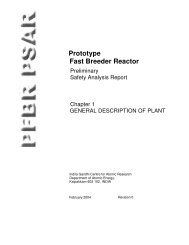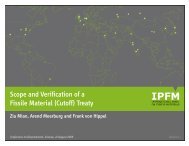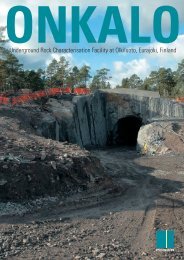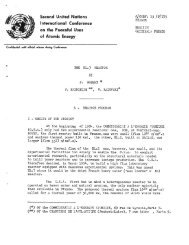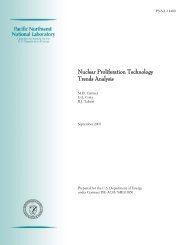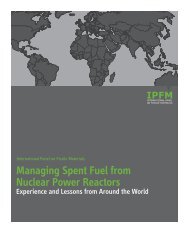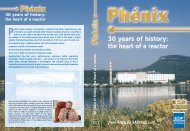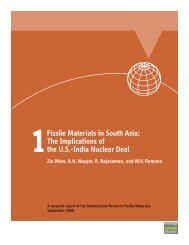Global Fissile Material Report 2009: A Path to Nuclear Disarmament
Global Fissile Material Report 2009: A Path to Nuclear Disarmament
Global Fissile Material Report 2009: A Path to Nuclear Disarmament
You also want an ePaper? Increase the reach of your titles
YUMPU automatically turns print PDFs into web optimized ePapers that Google loves.
of nuclear materials, including all plu<strong>to</strong>nium and uranium of all enrichments, theAEC, after the enactment of the A<strong>to</strong>mic Energy Act of 1954, implemented a comprehensiveset of accounting procedures. For the first time, facilities had a set of reportingrequirements reflecting generally accepted principles of the accounting profession.Due <strong>to</strong> the variability and complexity in the different nuclear fuel cycle facilities andprocesses, no particular accounting system was specified; however, requirements includeddouble-entry bookkeeping and nuclear material transactions recording in order<strong>to</strong> track the status of any materials within a facility.In the early 1960s, the AEC engaged the Stanford Research Institute (SRI) <strong>to</strong> performa feasibility study on developing a headquarters management information system fornuclear materials. In 1963 the SRI study recommended that a national system be builtand, in 1964, the project was begun in Oak Ridge, Tennessee. The NMMSS has beenau<strong>to</strong>mated since 1965.Union Carbide built the new system. Union Carbide seemed <strong>to</strong> be a logical choicebecause, at that time, it operated three nuclear plants in Oak Ridge (Y-12, X-10 andK-25) plus the uranium enrichment plant in Paducah, Kentucky and was well informedregarding the principles of nuclear materials accounting. In addition <strong>to</strong> the Union Carbidesystem, Oak Ridge continued <strong>to</strong> maintain the AEC mandated accounting recordsof nuclear materials in commercial facilities.The first nuclear materials in NMMSS were of 12 types:••••••••••••Depleted uraniumEnriched uranium (broken down in<strong>to</strong> HEU ranges and LEU based on containedU-235)Plu<strong>to</strong>nium (broken up in<strong>to</strong> weapon-grade and lesser grades)Lithium enriched in Li-6Uranium-233Natural uraniumNeptunium-237Plu<strong>to</strong>nium-238DeuteriumTritiumThoriumUranium in cascades (i.e., unified uranium: depleted, normal, and enriched)NMMSS began tracking helium-3 in 1969 and discontinued tracking it in July 1978.Normal and depleted lithium were reported by contrac<strong>to</strong>rs beginning in 1971 and discontinuedtwo years later. In 1974, six types of materials in the transuranium groupwere added and all but berkelium (removed in 2006) have remained in the system.These material types are as follows:••••••Plu<strong>to</strong>nium-242Americium-241Americium-243CuriumBerkeliumCalifornium44 <strong>Global</strong> <strong>Fissile</strong> <strong>Material</strong> <strong>Report</strong> <strong>2009</strong>



